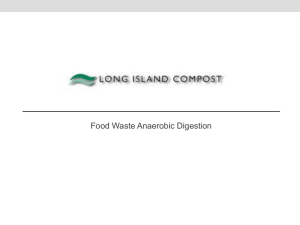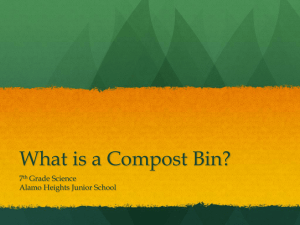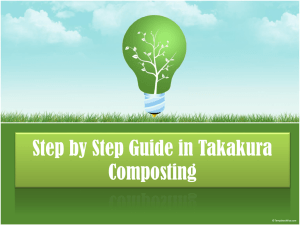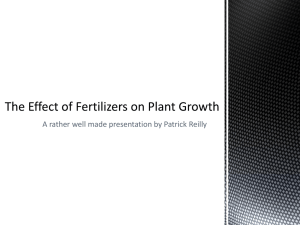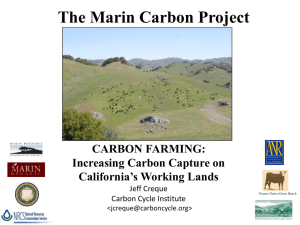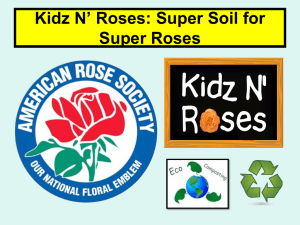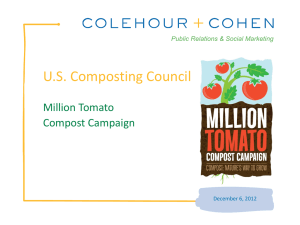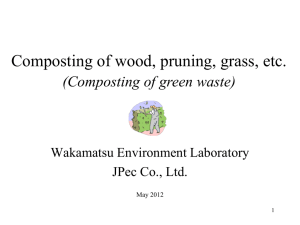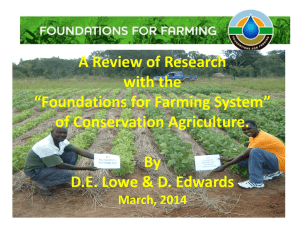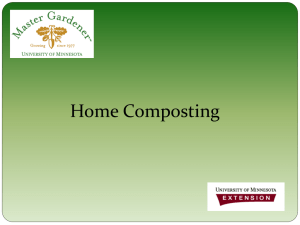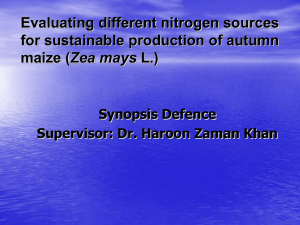Sue Edwards
advertisement
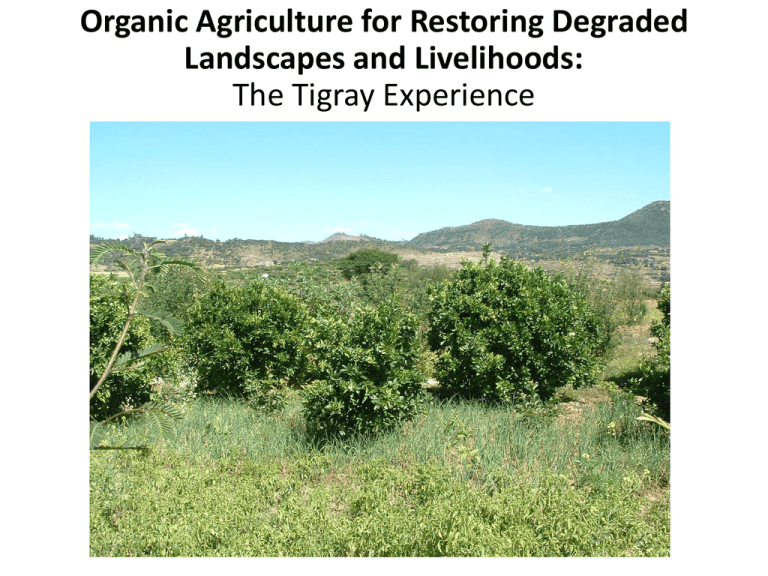
Organic Agriculture for Restoring Degraded Landscapes and Livelihoods: The Tigray Experience Tigray ETHIOPIA Mountainous 1.12 mill sq km >14 mill smallholder farmers >Cultivated area average 0.94 ha per family Addis Ethiopia is the ‘water tower’ of eastern Africa providing over 80% of the waters of the Nile plus water to N Kenya, Somalia and Djibouti. Land degradation, particularly soil erosion is Ethiopia’s most serious problem Any and all agricultural improvements need to be based on ecological intensification Ethiopia’s agrobiodiversity wealth • Over 5,000 years of farmers’ knowledge and skills • Agro-biodiversity wealth – Vavilov Centre with over 190 crop species still cultivated – Great varietal diversity within crops – Very low use of external inputs, e.g. chemical fertilizer – Farmers’ dislike / distrust of debt • Governance in the hands of local communities, including farmers’ rights to save, use and sell their own seed A glimpse of Ethiopia’s agrobiodiversity wealth Enset (false banana) above and teff below A few of the huge range of sorghum varieties Local Agroiodiversity for Food & Nutrition Security and Income Generation Enset: 250 sq m supplies all carbohydrate needed for a family of 5 for a year • Harvested product can be stored for 15 years • Highly drought resistant Teff: highest value cereal on market (85 USD/t), compared to maize, (25 USD/t) • High nutritional value, • Harvested grain can be stored for 10 years without loosing viability Sorghum: very drought resistant • Many different food and beverages uses #IFOAMRio @IFOAMorganic Origin of the Tigray Project In mid-1990s, ISD asked by the Ethiopian Government for an alternative to the Sasakawa Global approach promoting increased use of chemical fertilizer, but suitable for only about 10% of the country--classified as high production potential areas • ISD established in 1996 to implement the Project “Sustainable Development and Ecological Land Management with Farming Communities in Tigray” = The Tigray Project #IFOAMRio @IFOAMorganic Livelihood and landscape components Bylaws - communities restore local control Biological and physical water & soil conservation, through using multipurpose local trees, i.e. Sesbania and local grasses Managing grazing, stopping access to vulnerable land (watersheds), so grass, herbs and trees can grow Restoring soil fertility through compost, and helping farmers avoid debt paid for chemical fertilizer Mature compost Making compost Sesbania in flower #IFOAMRio @IFOAMorganic Landscape rehabilitation started in 1996, pictured in 2003 (similar examples now seen in many place) throughout Pond Rehabilitated gullies Sesbania trees and long grasses Rehabilitated biodiverse hillside for bee keeping Faba bean Composted fields growing tef, wheat and barley #IFOAMRio @IFOAMorganic The 4 Principles of Organic Agriculture Applied • Ecology – restores and maintains ecosystem services (good soil, water availability, pollinators) • Health – healthy soil produces disease and pest resilient crops • Fairness – Involves all social groups in the local communities, women, men, disadvantaged groups such as elderly couples, landless youth, families challenged by HIV/AIDS, etc. • Care – the communities take responsibility for caring for their environment through bylaws Impact of compost on crop health & disease resistance, example from 2010 #IFOAMRio @IFOAMorganic Wheat infested with stripe rust and sprayed – gave yield of 1.6 t/ha Wheat grown on composted soil resisting the rust – gave yield over 6.5 t/ha Landscape Benefits of Compost Carbon brought back to the soil as humus Nitrogen in the protein of organic wastes, including urine, returned to the soil Other nutrients in compost recycled for healthy growth of crops, animals and people Water retention for improved local hydrology, with raised water tables, longer water flows in streams enabling 2 crops per year Increased resilience to extreme weather events Livelihood benefits of compost Yields of cereals and pulses doubled Soil and crops with increased resistance to wind and water erosion Water availability improved Springs reappear, persist and streams run for longer through the year Water tables raised (farmers dig shallow hand dug wells) Crops survive dry gaps and stay green for 2 weeks longer than others at the end of rains #IFOAMRio @IFOAMorganic #IFOAMRio @IFOAMorganic Yield of Faba Bean with compost 2,500 kg/ha Yield of Faba Bean without compost 250kg/ha #IFOAMRio @IFOAMorganic Grain yield of 5 staple crops from farmers (2000 to 2006) 4000 Based on samples from 900 plots Check Compost Chemical fertilizer 3500 3000 2500 2000 1500 1000 500 0 Barley (n=444) Durum wheat Maize (n=273) Teff (n=741) Faba bean (n=546) (n=141) Crop (n=number of observations/fields sampled) #IFOAMRio @IFOAMorganic Additional Livelihood Benefits of Compost Farmers avoid debt from getting chemical fertilizer on credit – now costing USD 130 per 100 kg – Farmers making bioslurry compost can sell one sack (approx. 100 kg for ETB 100 or USD 5.8 – Competent farmers make 35 to 100 sacks a year Farmers, particularly women, diversify their production base Women say the food tastes better and their families’ hunger is satisfied more easily Economic benefits of compost • Inputs (all of which are locally available): – weeds from crop fields – Left over crop residues used as animal feed and bedding – Animal manure (plentiful) – Vegetable crop residues – Household organic wastes – Labour – Water – Microbial rich soil as an innoculator Cost benefit analysis for the farmer using chemical fertilizer • Cost for chemical fertilizer in 2012 was USD 130 per 100 kg • Average yield of durum wheat grown with chemical fertilizer 1700 kg/ha, • Sold at USD 50 per 100 kg , farmers income would be USD 850 • Net profit after repaying credit, USD 720 Cost benefit analysis for the farmer from using compost • Average rate of compost application, 6.5 t/ha • Opportunity cost for making compost estimated at USD 60 for 6.5 t/ha • Average yield of durum wheat grown with compost 2500 kg/ha, • Sold at USD 50 per 100 kg , farmers income would be USD 1,250 • As there is no financial outlay, ALL of this profit stays with the farmer Mixed perennial and annual crops Hillside protected from grazing Water pond for irrigation Farmer Woldu Fields of mature teff Fruit tree garden in rehabilitated gully Harvested teff field #IFOAMRio @IFOAMorganic Planting with Space to maximize use of seed and compost An adaptation of SRI, by growing in rows either from transplanting seedlings or direct sowing, gives Increased yields with easier and timely management of weeds, pests and easier harvesting e.g. Finger millet and tef, seed rate reduced by 90% compared to broadcasting, hence more efficient use of seed resources, and Grain and straw yields doubled, i.e. for finger millet from 1.4 t/ha to 3 t/ha grain, and for tef from 1.2 t/ha to 2.5 t/ha or more of grain Because, root growth greatly increased giving many more productive tillers (greater root mass = greater shoot mass) Participatory Planting with Space #IFOAMRio @IFOAMorganic Productive Tiller Potential of Teff planted with space and compost #IFOAMRio @IFOAMorganic Tiller production increased At harvest impact of ecological intensification on biomass Productive Ear/Grain Potential of Durum wheat planted with space and compost Ear with 39 grains without space or compost Ear with 56 grains with space and compost The Ecological way ahead is: knowledge & people intensive #IFOAMRio @IFOAMorganic • Improve and expand extension services (ICT) • Introduce capacity building (ICT) • Agriculture is very localized www.organicfarmermagazine.org www.infonet-biovision.org http://www.biovision.ch THANK YOU Sue Edwards, with Tewolde Berhan Gebre Egzibher Dereje Gebremichael, Hailu Araya, and Arefayne Asmelash Institute for Sustainable Development, Ethiopia sustaindeveth@ethionet.et / sustainet@yahoo.co.uk
